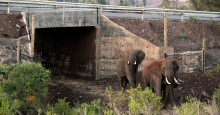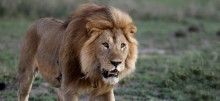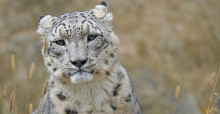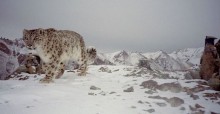Согласно последнему отчету климатической группы Организации Объединенных Наций, изменение климата происходит намного быстрее, чем ученые прогнозировали менее десяти лет назад. Глобальное потепление уже привело к учащению экстремальных погодных явлений, интенсивному таянию ледников и более частым сходам лавин, наводнениям, оползням и селям в горах Центральной Азии.
Uncia uncia
Снежный барс (Uncia Uncia) является одной из самых известных больших диких кошек, населяющих горные ландшафты Афганистана, Бутана, Китая, Индии, Казахстана, Кыргызской Республики, Монголии, Непала, Пакистана, Российской Федерации, Таджикистана и Узбекистана. Основные места его обитания включают территории Алтая, Тянь-Шаня, Кунь Луня, Памира, Гиндукуша, Каракорума и Гималаи. Большинство исследований оценивает общую численность популяций снежного барса всего лишь в 4,500 – 6,000 особей. Это, в значительной степени одиночное, животное с низкой до очень низкой плотности популяции, населяет обширные территории горных хребтов на высоте от 540 м до более чем 5,000 над уровнем моря. Низкая плотность и обширные территорий распространения зачастую приводят к тому, что сохранение жизнеспособных популяций в пределах особо охраняемых природных территорий не может быть достигнуто и комплексные меры по охране ландшафта согласованные всеми государствами ареала особенно необходимы для сохранения популяций снежного барса. Кроме того, до одной трети всех известных популяций этого животного проживает в приграничных территориях, а именно, менее чем в 50 – 100 км от государственных границ 12 стран ареала. Поэтому укрепление трансграничного сотрудничества по сохранению снежного барса между государствами ареала является приоритетной деятельностью.
Наибольшие угрозы для снежного барса включают в себя: потерю мест обитания и кормовой базы, браконьерство, а также конфликт с местным населением в связи с охотой снежного барса на домашний скот. Браконьерство и незаконная торговля были наиболее распространены в бывших Советских Республиках в 1990-х в связи с неблагоприятной экономическими условиями. В то время, как ситуация в этих странах улучшилась, незаконная торговля, вероятно продолжается в большинстве стран ареала в связи с растущим спросом на барсов на черном рынке. Охрана снежного барса также усложняется из-за ограниченных научных данных о существующих популяциях и пробелов в законодательстве, управление и природоохранной политике.
Сохранение снежного барса
Признавая существующие угрозы, Стороны КМВ, внесли снежного барса в Приложение IКонвенции в 1986 году, требуя от государств ареала строгую охрану этого вида. Снежный барс также включен в Рекомендацию 9.3 по тиграм и другим большим азиатским кошачьим. Данная рекомендация призывает государства ареала к принятию мер по улучшению трансграничного сотрудничества по сохранению и рациональному использованию кошачьих, а также рекомендует потенциальным донорам увеличить финансовую поддержку данного сотрудничества. Резолюция 11.13 11-ой Встречи сторон КМВ, также рекомендует странам ареала разработать согласованные действия по сохранению снежного барса. Центрально-Азиатская Инициатива по Млекопитающим (ЦАИМ) КМВ охватывает 14 стран и 15 видов, в том числе снежного барса и архара, один из его видов-жертв. ЦАИМ была создана с целью обеспечения комплексного подхода к охране мигрирующих животных. Программа Работы (ПР) и Резолюция ЦАИМ были приняты в 2014 году на 11-ой Встрече Сторон КМВ. Действия направленные на сохранение снежных барсов и архаров, населяющих схожие горные экосистемы приведены в соответствие с усилиями по сохранению вида в рамках Глобальной программы по сохранению снежного барса и его экосистем (ГПССБЭ). ГПССБЭ была инициирована Правительством Кыргызской Республики при поддержке Глобальной инициативы по тиграм Всемирного Банка и объединила представителей всех 12 государств ареала, неправительственных организаций, межправительственных организаций, местных общин и частный сектор. Программа направлена на обеспечение долгосрочного выживания снежного барса в его естественной среде обитания через установление трансграничного сотрудничества направленного на сохранение целостности ландшафтов, в которых обитает барс.
Снежный барс также внесен в Приложение I СИТЕС, запрещающее международную торговлю данным видом и его дериватами, за исключением особых случаев и некоммерческих целях.
 The Snow Leopard (Uncia uncia) is an iconic great wild cat inhabiting mountain terrains in Afghanistan, Bhutan, China, India, Kazakhstan, the Kyrgyz Republic, Mongolia, Nepal, Pakistan, the Russian Federation, Tajikistan, and Uzbekistan with core areas including the Altai, Tian Shan, Kun Lun, Pamir, Hindu Kush, Karakorum and Himalayan ranges. The estimated global population of Snow Leopards is as few as 4,500 – 6,000 animals. It is a largely solitary animal that lives at low to very low densities and requires large ranges in the mountains at elevations from 540 to more than 5,000 metres above sea level. Designated protected areas, even though an important conservation mechanism, are often too small to cover significant part of the large areas occupied by the Snow Leopard and do not allow to achieve the conservation of viable populations. Thus, concerted landscape-wide measures are necessary to ensure the survival of the species’ populations. Furthermore, up to one third of the known Snow Leopard population might have a range located less than 50 – 100 km from the international borders of 12 range countries. Therefore, strengthening of transboundary collaboration is particularly important for the conservation of the Snow Leopard.
The Snow Leopard (Uncia uncia) is an iconic great wild cat inhabiting mountain terrains in Afghanistan, Bhutan, China, India, Kazakhstan, the Kyrgyz Republic, Mongolia, Nepal, Pakistan, the Russian Federation, Tajikistan, and Uzbekistan with core areas including the Altai, Tian Shan, Kun Lun, Pamir, Hindu Kush, Karakorum and Himalayan ranges. The estimated global population of Snow Leopards is as few as 4,500 – 6,000 animals. It is a largely solitary animal that lives at low to very low densities and requires large ranges in the mountains at elevations from 540 to more than 5,000 metres above sea level. Designated protected areas, even though an important conservation mechanism, are often too small to cover significant part of the large areas occupied by the Snow Leopard and do not allow to achieve the conservation of viable populations. Thus, concerted landscape-wide measures are necessary to ensure the survival of the species’ populations. Furthermore, up to one third of the known Snow Leopard population might have a range located less than 50 – 100 km from the international borders of 12 range countries. Therefore, strengthening of transboundary collaboration is particularly important for the conservation of the Snow Leopard.
Major threats to the Snow Leopard include habitat loss and degradation resulting among other negative effects in the depletion of prey base, poaching, and conflict with local human populations due to the killing of livestock. Poaching and illegal trade were most severe in the former Soviet Republics in the 1990s due to the harsh economic conditions. While the situation has improved there, the illegal trade is likely to continue in large parts of the Snow Leopard range given growing demand for its derivatives.Conservation of the species is also a challenge because there is limited knowledge about its population and often inadequate conservation, policy and management capacities.
Photo credit: Snow Leopard Conservancy
Conservation
Recognizing existing threats, CMS Parties listed the Snow Leopard under Appendix I in 1986, requiring from Range States a strict protection of this species. Furthermore, the Snow Leopard is covered by the Recommendation 9.3. Tigers and Other Asian Big Cats that calls range states to enhance mutual transboundary cooperation for the conservation and management of tigers and other Asian big cat species throughout their range and potential donor countries to provide or increase financial support for conservation of Asian big cat species. It is also designated by the COP11 Resolution 11.13 for concerted actions during 2015 – 2017. Additionally, the CMS Central Asian Mammals Initiative (CAMI) covers 14 countries and 15 species, including the Snow Leopard and its prey species, the Argali, aiming to provide a coherent framework for the conservation of migrating animals. The CAMI Programme of Work (PoW) and Resolution were adopted in 2014 at the 11th CMS COP. The activities for Snow Leopards and Argali inhabiting similar mountain ecosystems are proposed to align to conservation efforts under a Global Snow Leopard and Ecosystem Protection Program (GSLEP). GSLEP was initiated by the Kyrgyz Government with support of the World Bank’s Global Tiger Initiative and joined together representatives of all 12 Range States, non-governmental organizations, inter-governmental organizations, local communities and the private sector. The programme aims to secure long-term survival of the Snow Leopard in its natural ecosystem through ensuring landscape-level transboundary conservation.
The Snow Leopard is currently listed in the IUCN Red List as globally endangered. The Snow Leopard is also included in CITES Appendix I which prohibits international trade in the animal and its parts and products except under exceptional, non-commercial circumstances.
| CMS Instruments | CMS, Central Asian Mammals Initiative |
|---|---|
| IUCN Status | Endangered |
| Date of entry in Appendix I | 1986 |
| Countries | Afghanistan, Bhutan, China, India, Kazakhstan, Kyrgyzstan, Mongolia, Nepal, Pakistan, Russian Federation, Tajikistan, Uzbekistan |
|---|
No pictures for Uncia uncia
| English | Snow Leopard |
|---|---|
| French | Panthère Des Neiges, Irbis, Once |
| Spanish | Pantera de las nieves, leopardo blanco |
| German | Schneeleopard, irbis |
| Class | Mammalia |
|---|---|
| Order | Carnivora |
| Family | Felidae |
| Scientific name | Uncia uncia |
| Author | Schreber 1775 |
| Standard reference | Wilson, D.E. & Reeder, D.M. Eds., 2005. Mammal Species of the World. A Taxonomic and Geographic Reference. Third Edition. John Hopkins University Press |
| Critical sites | Altay-Sayan (China, Kazakhstan, Mongolia, Russia); Junggar-Alatau (Kazakhstan, China); Saur-Tarbagatay (China, Kazakhstan); Inner Tien Shan (China, Kyrgyzstan); East Tien Shan (Kazakhstan, Kyrgyzstan, China); West Tien Shan (Kyrgyzstan, Uzbekistan, Kazakhstan); Hissar-Alay (Kyrgyzstan, Tajikistan, Uzbekistan); Pamir (Afghanistan, China, Tajikistan, Pakistan); Karakorum (Pakistan, Afghanistan, China); Central Himalaya (Bhutan, China, India, Nepal, Pakistan); Qinghai-Tibetan Plateau (China, and small areas of Bhutan, Nepal, India); Gobi (China, Mongolia); |
|---|---|
| Additional notes | Formerly listed as _Panthera uncia_. |
















